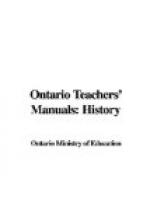2. Each Province had a Governor, a Legislative Council, a Legislative Assembly, and an Executive Council. The Legislative Council was composed of the highest officials, appointed practically for life, and responsible to no one. Many of these were also members of the Executive Council. The Legislative Assembly was elected and was yet without control of the whole revenue, as the Home Government still collected “all duties regulating colonial navigation and commerce.”
3. The Clergy Reserves
were established; later to become a bone of
contention.
V. 1841 to 1867—Act of Union to British North America Act.
The demands of the people for responsible government, that is, for control of the Executive and of taxation, became so insistent that the Act of Union was passed, following Lord Durham’s report on the Rebellion of 1837.
Provisions of the Act of Union:
1. Legislative Council appointed (20 members)
2. Legislative
Assembly elected (42 from each Province, later 65
from each)
3. Executive Council selected from both Houses
4. A permanent Civil List of L75,000 was granted
5. The Legislative
Assembly controlled the rest of the revenue.
Money bills were to
originate with the Government. This was really
Responsible Government,
as it was developed under Elgin.
VI. 1867 to the present:
The British North America Act was the statement of a complete victory of the people for Responsible Government. The Executive Council (Cabinet) is wholly responsible to Parliament, in which the members of the Executive must have seats; the raising and the spending of revenue is wholly in the hands of the people’s representatives. For a clear summary of the concessions won by Canadians, see Bourinot, How Canada is Governed, page 34; see also Ontario Public School History of Canada, pp. 267 et seq.
DEVICES
MAPS
1. Wall maps for general study, especially of modern history.
2. Outline or sketch maps drawn on the black-board by the teacher or the pupils for use in the study of earlier history, or explorations, etc. For these purposes the details of a wall map are not only not needed, but are rather a hindrance.
3. Relief maps of plasticine, clay, or salt and flour, to be made by the pupils to illustrate the influence of geographical facts in history, and to make events in history more real to the pupils.
PICTURES
1. Many good historical pictures of persons, buildings, monuments, and events may be collected by the pupils and the teacher from magazines and newspapers, and pasted in a scrap-book. (See Educational Pamphlet, No. 4, Visual Aids in the Teaching of History.)




